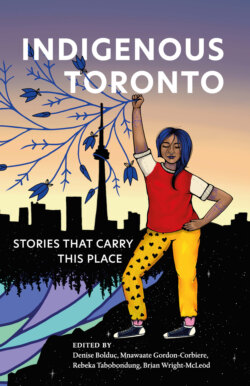Читать книгу Indigenous Toronto - Группа авторов - Страница 14
На сайте Литреса книга снята с продажи.
THE JOURNEY OF THE MISSISSAUGAS OF THE CREDIT FIRST NATION
ОглавлениеIn 1985, the Mississauga Nation (Mississaugas of the Credit, Alderville, Scugog, Curve Lake, and Hiawatha First Nations) came together to meet about their land claims and the treaties made in the past. The following year, the Mississauga Tribal Claims Council submitted the Toronto Purchase to the federal government’s Specific Claims Tribunal.
Toronto Purchase (1787).
Canada rejected the claim in 1993 due to inaction by the MTCC. But the Oka Crisis had occurred during that time, resulting in the formation of the Indian Claims Commission. It could conduct an inquiry into a rejected claim and make a recommendation to the federal government to negotiate a land claim. Yet this body lacked the authority to compel the federal government to take action.
Until then, First Nations had to take their land claims to court, which is a costly process. The Mississaugas of the Credit were able to submit claims, as they were not signatories to the 1923 Williams Treaties. First Nations had grown tired of hearing ‘take it or leave it’ from federal negotiators. In February 1998, the Mississaugas of the Credit requested an independent inquiry into the Toronto Purchase. This process included the First Nation, the Department of Justice, and the ICC as facilitator. After three planning sessions, Canada agreed to review the claim.
On March 8, 1999, the Mississaugas of the Credit submitted a new legal opinion, including a position on the Toronto Islands. The claim was accepted on the basis of the fact that the 1805 treaty was valid, meaning the Toronto Islands were included. It was a difficult task trying to fit a square into a circle in order to keep the claim moving.
The Justice Department raised the question of beneficiaries. Were the Mississaugas the sole beneficiaries of the Toronto Purchase? The Mississaugas of the Credit submitted a paper on September 9, 1999, to address this issue (i.e., identifying the rightful First Nation to make this claim), which the federal government accepted. The Mississaugas of the Credit were declared the sole beneficiaries of the Toronto Purchase, but the door was left open for other Mississauga First Nations to advance claims.
The next challenge concerned the compensation received in 1787. The government said the Mississaugas of the Credit had received annual presents and were trying to price them. The annual presents had been provided by the British for a military alliance, not a land sale. A position paper making this argument was submitted on October 18, 1999, and accepted by the federal government. On that basis, the ICC recommended that the federal government negotiate the Mississaugas’ claim over the Toronto Purchase, and the federal government accepted the recommendation to begin negotiations on July 23, 2002.
Throughout this process, a lot of political lobbying and meetings had taken place. One of the points the planning committee agreed on early in the process was to keep the same teams on the government’s side and the First Nation’s side, as far as possible. This was accomplished, and the two groups worked well together.
On June 17, 2003, a joint media briefing was held to announce that the negotiations were finally underway. These negotiations moved quickly to the question of compensation, as most of the arguments had been discussed and resolved during the inquiry phase.
Between August 2002 and March 31, 2007, David Walker served as the chief negotiator for the federal government. Then, on September 26, 2007, the government – with input from the First Nation – named former Toronto mayor David Crombie to replace Walker.
One of the first points agreed upon by the two parties was to conduct joint research on the interest rates from 1805 to 1900. The federal government argued that Canada had no banking system in 1805. The study was done by an independent consultant, who found that Canada did have a banking system, and paid 6 per cent interest through the years.
All the work done through the years by all parties finally came to fruition on January 25, 2010, with a joint announcement that the federal government would make an offer of $145 million, which included compensation for the Brant Tract Treaty (1797) that covered 3,450 acres between what is now Hamilton and Burlington.
The First Nation had their work cut out for them now. Meetings with the membership had been taking place during the whole process to keep them up-to-date on the progress of the claim. A trust agreement and then a settlement agreement had to be drafted, based on input from the membership.
The trust agreement included a per capita distribution, a Community Wellness Policy, and an Estate Policy. On May 29, 2010, the Mississaugas of the Credit voted in favour of the Toronto Purchase Settlement Agreement.
Reflecting back over the years of this journey, from start to finish, was not an easy task. A lot of hard work and sometimes difficult choices had to be made by the First Nation. I believe that the Mississaugas of the Credit made a decision that was to their members’ benefit. If the First Nation had sued the federal government over this claim, we probably would still be in court, or would have had to withdraw for lack of funds. Many of our elderly members would have passed away during the process, without seeing the end or any benefit, and the only ones getting rich would have been litigation lawyers. I have nothing against lawyers, but that is the truth. The Mississaugas of the Credit would not have benefited at all.
Today, instead, the membership benefits every year, thanks to the settlement of the Toronto Purchase.
